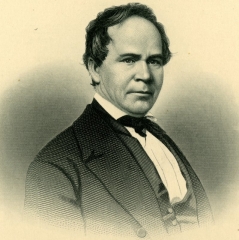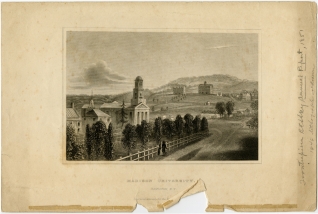them for funds for the University of Rochester. Both sides sought particularly to win over the wealthy iron merchant and philanthropist, Garrat N. Bleecker, who proved to be a decided Madison supporter; his check for $3,000 was the largest single contribution to the endowment. Other agents circulated among the upstate Baptist churches, and there, also, met rivals from Rochester. The solicitors for both institutions proved remarkably successful, thanks to the high level of agricultural prosperity then prevailing in the region. By August 1851, the friends of Madison, having exceeded their goal of $60,000 by $7,000, were ready to lift it to $100,000, a sum they did not achieve.
The University endowment drive naturally cut into the Education Society’s income since its patrons had first to pay their endowment pledges, and consequently the latter organization had a deficit of about $15,000 for several years. The Society had originally incurred most of its indebtedness by attempting to support more beneficiaries than funds permitted. Then, the growing apathy of the churches to the cause of ministerial education in the late ’50’s and the demands of charities attendant on the Civil War greatly reduced annual contributions. The University treasury likewise experienced stringency, forcing the Trustees in 1861 to cut salaries.
To Professors Spear, Eaton and others, invested funds seemed the answer to financial worries. Despite his $2,000 contribution to the endowment in 1850, Deacon Colgate resolutely opposed this means of support, citing Scriptural caution against “anxious care for the morrow”
and “distrusting our Lord for the future.”
As Dr. Eaton wrote years later, “This had been good advice, had all been like-minded with him and been as ready to give according to their ability.”
Fortunately for the University, the Deacon’s friend, Garrat Bleecker, dissented, and in 1853 left the institution $12,000 which, with the $3,000 he had given in 1850, he directed to be used as the foundation for the University’s first chair, the Bleecker Professorship of Intellectual and Moral Philosophy.
Professor Spear, noting that the University’s invested funds had mitigated the effect of the Panic of 1857 on its treasury, urged Deacon Colgate’s sons, James B. and Samuel, to assist in raising $30,000 for its sister corporation, the Education Society, and, more particularly, to establish a Colgate professorship by adding $13,000 to the $2,000 their father had given to the original endowment, The latter idea did not







